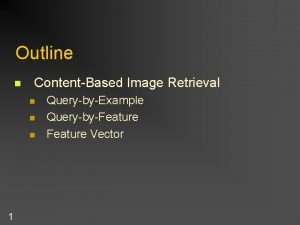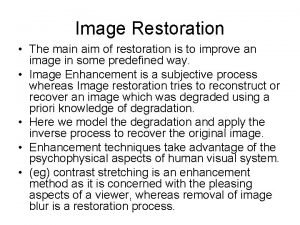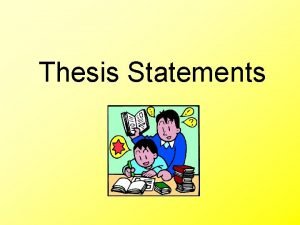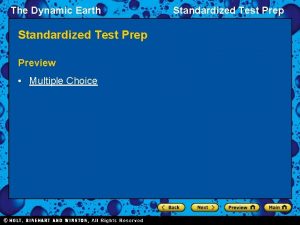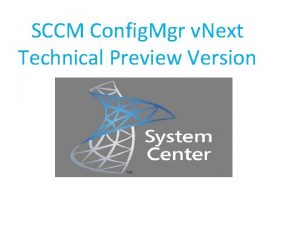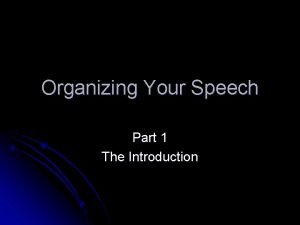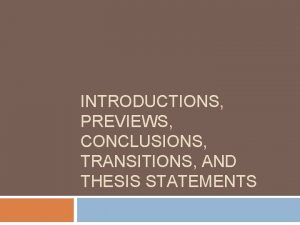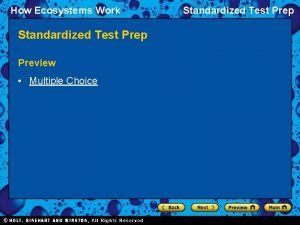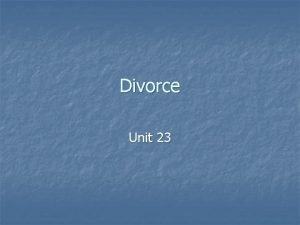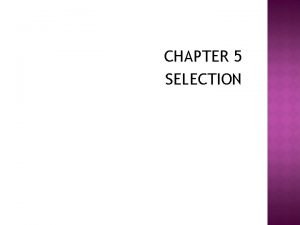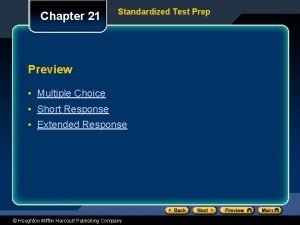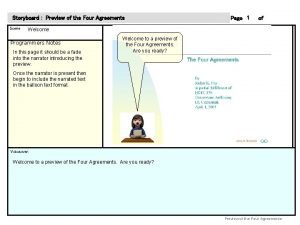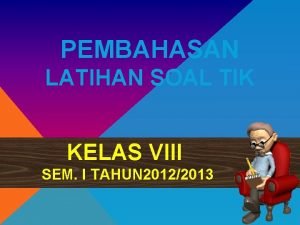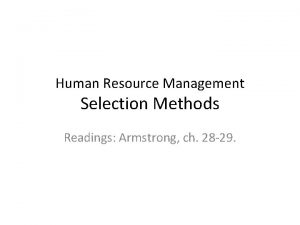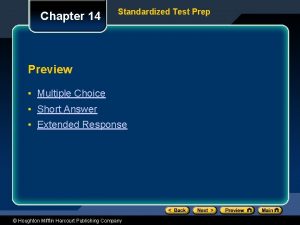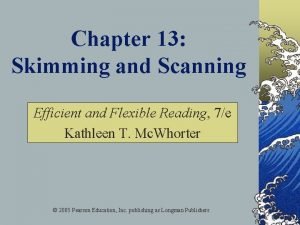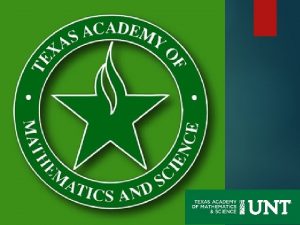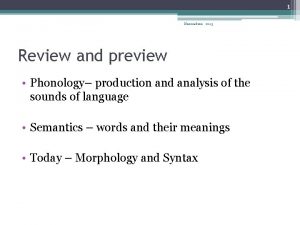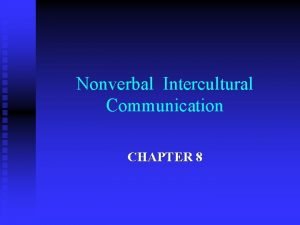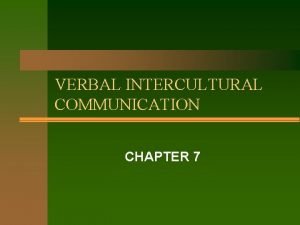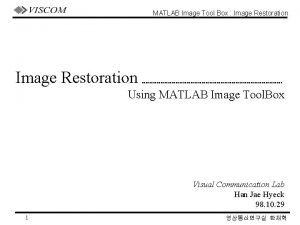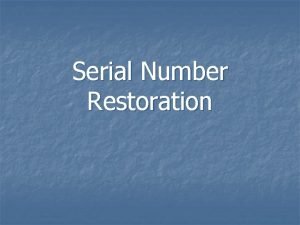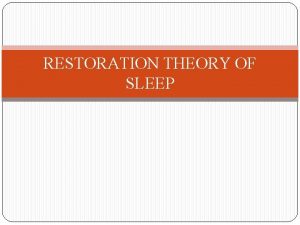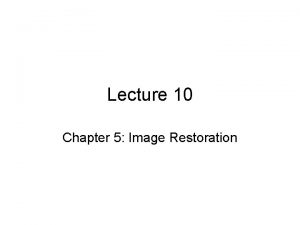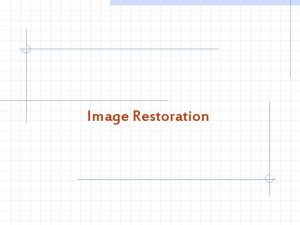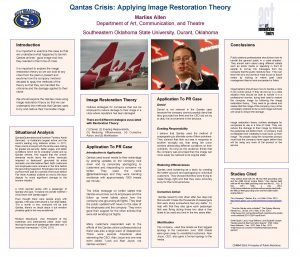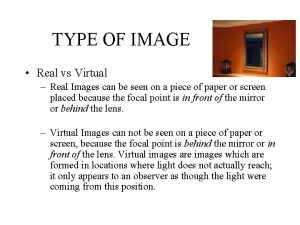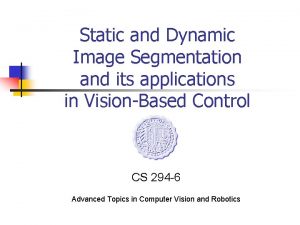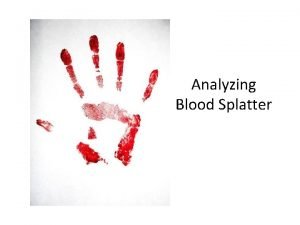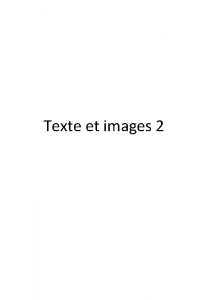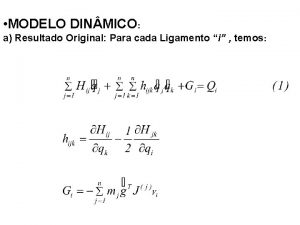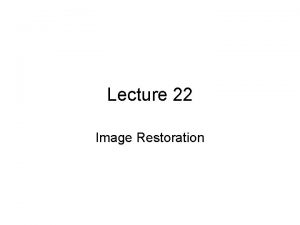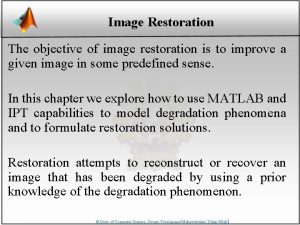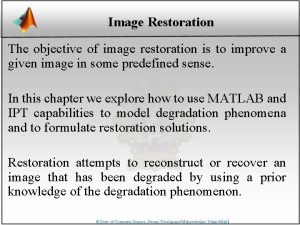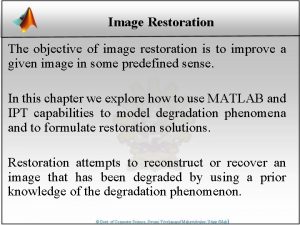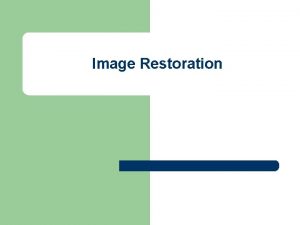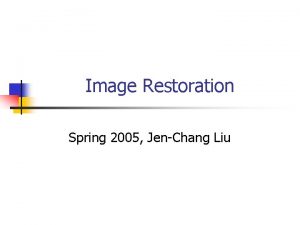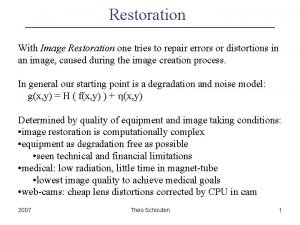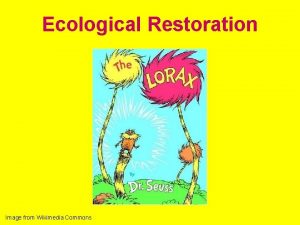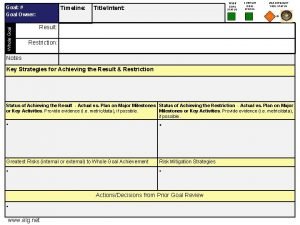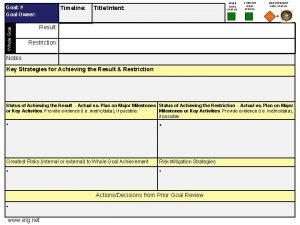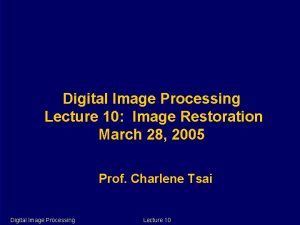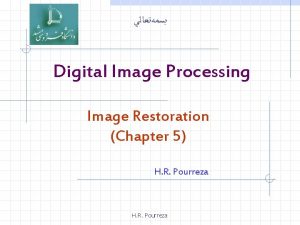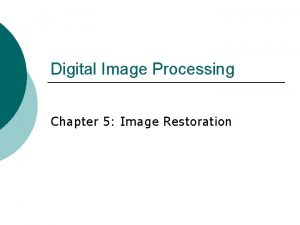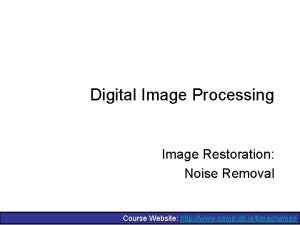Image Restoration Preview n Goal of image restoration








![Gaussian noise (PDF) 70% in [(m-s), (m+s)] 95% in [(m-2 s), (m+2 s)] Gaussian noise (PDF) 70% in [(m-s), (m+s)] 95% in [(m-2 s), (m+2 s)]](https://slidetodoc.com/presentation_image_h/a7d3350565f8e02507e01e02cc3c0560/image-9.jpg)

















































- Slides: 58

Image Restoration

Preview n Goal of image restoration n Improve an image in some predefined sense Difference with image enhancement ? Features n n n Image restoration v. s image enhancement Objective process v. s. subjective process A prior knowledge v. s heuristic process A prior knowledge of the degradation phenomenon is considered Modeling the degradation and apply the inverse process to recover the original image

Preview (cont. ) n Target n n Degraded digital image Sensor, digitizer, display degradations are less considered Spatial domain approach Frequency domain approach

Outline n n n n A model of the image degradation / restoration process Noise models Restoration in the presence of noise only – spatial filtering Periodic noise reduction by frequency domain filtering Linear, position-invariant degradations Estimating the degradation function Inverse filtering

A model of the image degradation/restoration process g(x, y)=f(x, y)*h(x, y)+h(x, y) G(u, v)=F(u, v)H(u, v)+N(u, v)

Noise models 雜訊模型 n Source of noise n n n Spatial properties of noise n n n Image acquisition (digitization) Image transmission Statistical behavior of the gray-level values of pixels Noise parameters, correlation with the image Frequency properties of noise n n Fourier spectrum Ex. white noise (a constant Fourier spectrum)

Noise probability density functions n n Noises are taken as random variables Random variables n Probability density function (PDF)

Gaussian noise n n Math. tractability in spatial and frequency domain Electronic circuit noise and sensor noise mean Note: variance
![Gaussian noise PDF 70 in ms ms 95 in m2 s m2 s Gaussian noise (PDF) 70% in [(m-s), (m+s)] 95% in [(m-2 s), (m+2 s)]](https://slidetodoc.com/presentation_image_h/a7d3350565f8e02507e01e02cc3c0560/image-9.jpg)
Gaussian noise (PDF) 70% in [(m-s), (m+s)] 95% in [(m-2 s), (m+2 s)]

Uniform noise n Less practical, used for random number generator Mean: Variance:

Uniform PDF

Impulse (salt-and-pepper) nosie n Quick transients, such as faulty switching during imaging If either Pa or Pb is zero, it is called unipolar. Otherwise, it is called bipoloar. • In practical, impulses are usually stronger than image signals. Ex. , a=0(black) and b=255(white) in 8 -bit image.

Impulse (salt-and-pepper) nosie PDF

Test for noise behavior n Test pattern Its histogram: 0 255


Periodic noise n n n Arise from electrical or electromechanical interference during image acquisition Spatial dependence Observed in the frequency domain

Sinusoidal noise: Complex conjugate pair in frequency domain

Estimation of noise parameters n Periodic noise n n Observe the frequency spectrum Random noise with unknown PDFs n Case 1: imaging system is available n n Capture images of “flat” environment Case 2: noisy images available n n n Take a strip from constant area Draw the histogram and observe it Measure the mean and variance

Observe the histogram Gaussian uniform

Measure the mean and variance n Histogram is an estimate of PDF Gaussian: m, s Uniform: a, b

Outline n n n n A model of the image degradation / restoration process Noise models Restoration in the presence of noise only – spatial filtering Periodic noise reduction by frequency domain filtering Linear, position-invariant degradations Estimating the degradation function Inverse filtering

Additive noise only g(x, y)=f(x, y)+h(x, y) G(u, v)=F(u, v)+N(u, v)

Spatial filters for de-noising additive noise n n Skills similar to image enhancement Mean filters Order-statistics filters Adaptive filters

Mean filters n Arithmetic mean Window centered at (x, y) n Geometric mean

original Noisy Gaussian m=0 s=20 Arith. mean Geometric mean

Mean filters (cont. ) n Harmonic mean filter n Contra-harmonic mean filter Q=-1, harmonic Q=0, airth. mean Q=+, ?

Pepper Noise 黑點 Contraharmonic Q=1. 5 Salt Noise 白點 Contraharmonic Q=-1. 5

Wrong sign in contra-harmonic filtering Q=-1. 5 Q=1. 5

Order-statistics filters n Based on the ordering(ranking) of pixels n n n Suitable for unipolar or bipolar noise (salt and pepper noise) Median filters Max/min filters Midpoint filters Alpha-trimmed mean filters

Order-statistics filters n Median filter n Max/min filters

bipolar Noise Pa = 0. 1 Pb = 0. 1 3 x 3 Median Filter Pass 2 3 x 3 Median Filter Pass 3

Pepper noise Salt noise Max filter Min filter

Order-statistics filters (cont. ) n Midpoint filter n Alpha-trimmed mean filter n Delete the d/2 lowest and d/2 highest gray-level pixels Middle (mn-d) pixels

Uniform noise m=0 s 2=800 Left + Bipolar Noise Pa = 0. 1 Pb = 0. 1 5 x 5 Arith. Mean filter 5 x 5 Geometric mean 5 x 5 Median filter 5 x 5 Alpha-trim. Filter d=5

Adaptive filters n n n Adapted to the behavior based on the statistical characteristics of the image inside the filter region Sxy Improved performance v. s increased complexity Example: Adaptive local noise reduction filter

Adaptive local noise reduction filter n Simplest statistical measurement n n Mean and variance Known parameters on local region Sxy n n g(x, y): noisy image pixel value s 2 h: noise variance (assume known a prior) m. L : local mean s 2 L : local variance

Adaptive local noise reduction filter (cont. ) n Analysis: we want to do n n If s 2 h is zero, return g(x, y) If s 2 L> s 2 h , return value close to g(x, y) If s 2 L= s 2 h , return the arithmetic mean m. L Formula

Gaussian noise m=0 s 2=1000 Arith. mean 7 x 7 Geometric mean 7 x 7 adaptive

Outline n n n n A model of the image degradation / restoration process Noise models Restoration in the presence of noise only – spatial filtering Periodic noise reduction by frequency domain filtering Linear, position-invariant degradations Estimating the degradation function Inverse filtering

Periodic noise reduction n Pure sine wave n Appear as a pair of impulse (conjugate) in the frequency domain

Periodic noise reduction (cont. ) n n Bandreject filters Bandpass filters Notch filters Optimum notch filtering

Bandreject filters * Reject an isotropic frequency ideal Butterworth Gaussian

noisy spectrum filtered bandreject

Bandpass filters n Hbp(u, v)=1 - Hbr(u, v)

Notch filters n Reject(or pass) frequencies in predefined neighborhoods about a center frequency ideal Butterworth Gaussian

Horizontal Scan lines DFT Notch pass Notch reject

Outline n n n n A model of the image degradation / restoration process Noise models Restoration in the presence of noise only – spatial filtering Periodic noise reduction by frequency domain filtering Linear, position-invariant degradations Estimating the degradation function Inverse filtering

A model of the image degradation /restoration process g(x, y)=f(x, y)*h(x, y)+h(x, y) G(u, v)=F(u, v)H(u, v)+N(u, v) If linear, position-invariant system

Linear, position-invariant degradation Properties of the degradation function H n Linear system n n Position(space)-invariant system n n n H[af 1(x, y)+bf 2(x, y)]=a. H[f 1(x, y)]+b. H[f 2(x, y)] H[f(x, y)]=g(x, y) H[f(x-a, y-b)]=g(x-a, y-b) c. f. 1 -D signal n LTI (linear time-invariant system)

Linear, position-invariant degradation model n n Linear system theory is ready Non-linear, position-dependent system n n n May be general and more accurate Difficult to solve compuatationally Image restoration: find H(u, v) and apply inverse process n Image deconvolution

Estimating the degradation function n Estimation by Image observation Estimation by experimentation Estimation by modeling

Estimation by image observation n Take a window in the image n n n Simple structure Strong signal content Estimate the original image in the window known estimate

Estimation by experimentation n n If the image acquisition system is ready Obtain the impulse response impulse Impulse response

Estimation by modeling (1) n Ex. Atmospheric model original k=0. 0025 k=0. 001 k=0. 00025

Estimation by modeling (2) n n Derive a mathematical model Ex. Motion of image Fourier transform Planar motion

Estimation by modeling: example original Apply motion model

Inverse filtering n With the estimated degradation function H(u, v) G(u, v)=F(u, v)H(u, v)+N(u, v) Unknown noise => Estimate of original image Problem: 0 or small values Sol: limit the frequency around the origin

Full inverse filter for Cut Outside 40% k=0. 0025 Cut Outside 70% Cut Outside 85%
 Nnn image preview
Nnn image preview Optimum notch filter in image processing
Optimum notch filter in image processing Cameraman.tif
Cameraman.tif Image restoration in digital image processing
Image restoration in digital image processing Thesis sentence example
Thesis sentence example Summary thesis statement
Summary thesis statement Test prep preview
Test prep preview Test prep preview
Test prep preview Test prep preview
Test prep preview Test prep preview
Test prep preview Sccm technical preview
Sccm technical preview Startling statement introduction examples
Startling statement introduction examples What is a preview statement
What is a preview statement Test prep preview
Test prep preview Nnn preview
Nnn preview The selection preview
The selection preview Chapter 21 standardized test practice answers
Chapter 21 standardized test practice answers The four agreements preview
The four agreements preview Test prep preview
Test prep preview Perintah print preview kita jalankan dari menu
Perintah print preview kita jalankan dari menu Classic trio' of selection techniques
Classic trio' of selection techniques Test prep preview
Test prep preview Overview skimming
Overview skimming 1984 book preview
1984 book preview Yandex ru video
Yandex ru video Nút lệnh print preview nằm ở đâu
Nút lệnh print preview nằm ở đâu Tams preview day
Tams preview day Review and preview
Review and preview Benefits of hr forecasting
Benefits of hr forecasting Disadvantages of realistic job preview
Disadvantages of realistic job preview Multi-channeled definition in communication
Multi-channeled definition in communication Preview speech
Preview speech Preview of main points
Preview of main points Fungsi movie task pane
Fungsi movie task pane Image sharpening in digital image processing
Image sharpening in digital image processing Image restoration matlab
Image restoration matlab Serial number restoration
Serial number restoration Restoration theory of sleep
Restoration theory of sleep Image restoration theory
Image restoration theory Image restoration adalah
Image restoration adalah Image restoration theory
Image restoration theory Reale vs virtuale
Reale vs virtuale Real vs virtual images
Real vs virtual images Image transform in digital image processing
Image transform in digital image processing Compression in digital image processing
Compression in digital image processing Key stage in digital image processing
Key stage in digital image processing Analog image and digital image
Analog image and digital image Huffman coding example
Huffman coding example Static image vs dynamic image
Static image vs dynamic image Geometric transformation in digital image processing
Geometric transformation in digital image processing Area of convergence
Area of convergence False contouring
False contouring Appuyez sur l’image qui est dans le bon sens
Appuyez sur l’image qui est dans le bon sens Difference between logical file and physical file
Difference between logical file and physical file Qual o resultado de: image image
Qual o resultado de: image image Image transforms in digital image processing
Image transforms in digital image processing Maketform matlab
Maketform matlab 余采樺
余采樺 Generative adversarial networks
Generative adversarial networks
